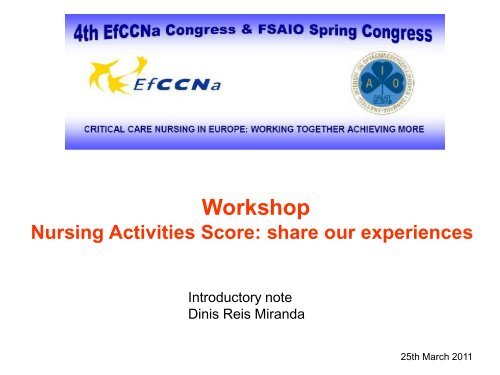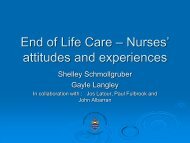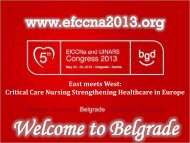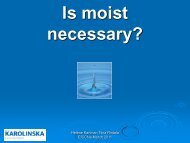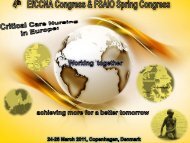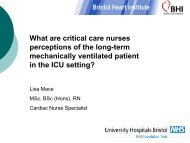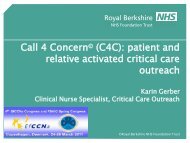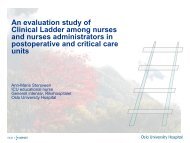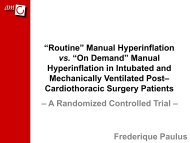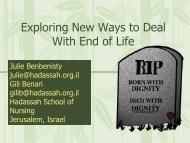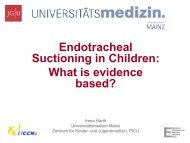Nursing Activities Score: a tool to measure nursing workload at ...
Nursing Activities Score: a tool to measure nursing workload at ...
Nursing Activities Score: a tool to measure nursing workload at ...
You also want an ePaper? Increase the reach of your titles
YUMPU automatically turns print PDFs into web optimized ePapers that Google loves.
Workshop<br />
<strong>Nursing</strong> <strong>Activities</strong> <strong>Score</strong>: share our experiences<br />
Introduc<strong>to</strong>ry note<br />
Dinis Reis Miranda<br />
25th March 2011
WHY <strong>measure</strong> <strong>nursing</strong> <strong>workload</strong><br />
Because:<br />
1. The number of FTE’s (available/required) is rel<strong>at</strong>ed <strong>to</strong><br />
- Effective planning of staffing<br />
- Costing/Budgeting the ICU (cost <strong>nursing</strong> staff = 30% <strong>to</strong>tal ICU costs)<br />
2. It helps <strong>to</strong> str<strong>at</strong>ify p<strong>at</strong>ient popul<strong>at</strong>ions<br />
3. It defines Levels of Care based on P/N r<strong>at</strong>ios
Of all instruments for measuring <strong>nursing</strong> <strong>workload</strong> in the ICU<br />
NAS is the best performer<br />
Because:<br />
• The items cover almost all <strong>nursing</strong> activities<br />
• The description of the items will easily accommod<strong>at</strong>e new activities<br />
• It explains 81% of Total <strong>Nursing</strong> Time
Because:<br />
1. The number of FTE’s (available/required) is rel<strong>at</strong>ed <strong>to</strong><br />
- Effective planning of staffing<br />
- Costing/Budgeting the ICU (cost <strong>nursing</strong> staff = 30% <strong>to</strong>tal ICU costs)<br />
2. It helps <strong>to</strong> str<strong>at</strong>ify p<strong>at</strong>ient popul<strong>at</strong>ions<br />
3. It defines Levels of Care based on P/N r<strong>at</strong>ios
THE USE OF NEMS<br />
criteria<br />
Severity<br />
High Care<br />
Mortality<br />
ICU<br />
HOSP<br />
13.0 20.4<br />
14.9 18.8<br />
Both<br />
34.6<br />
44.2<br />
Iapichino et al, 2005
Because:<br />
1. The number of FTE’s (available/required) is rel<strong>at</strong>ed <strong>to</strong><br />
- Effective planning of staffing<br />
- Costing/Budgeting the ICU (cost <strong>nursing</strong> staff = 30% <strong>to</strong>tal ICU costs)<br />
2. It helps <strong>to</strong> str<strong>at</strong>ify p<strong>at</strong>ient popul<strong>at</strong>ions<br />
3. It defines Levels of Care based on P/N r<strong>at</strong>ios<br />
Modern <strong>Nursing</strong> Care shall focus on<br />
Capacity, not Competence
N/P r<strong>at</strong>ios<br />
required<br />
M<strong>at</strong>ching Resources<br />
ICU<br />
Medium Care<br />
Em. Depart<br />
Rec-Room<br />
Ward<br />
0.1 0.5 1.0 N/P r<strong>at</strong>ios<br />
available
Understanding the use of NAS<br />
- Concerns the activities of care performed<br />
- Does not cover any P<strong>at</strong>ient/Nurse interaction<br />
Therefore…<br />
NAS is a <strong><strong>to</strong>ol</strong> for strictly planning/auditing<br />
<strong>nursing</strong> capacity in the ICU
Future studies<br />
• “Precise” the Manual of Use<br />
• The applicability across the Hospital<br />
Prof. K. Grillo Padilha<br />
Prof. R. Cardoso de Sousa
<strong>Nursing</strong> use in the ward versus the ICU<br />
1.<br />
General care<br />
WARD ICU<br />
2.<br />
Psycho-social care<br />
3.<br />
Specific care
Only 30% of the <strong>nursing</strong> time<br />
is used in direct rel<strong>at</strong>ion <strong>to</strong> the<br />
High Technology in the Unit


